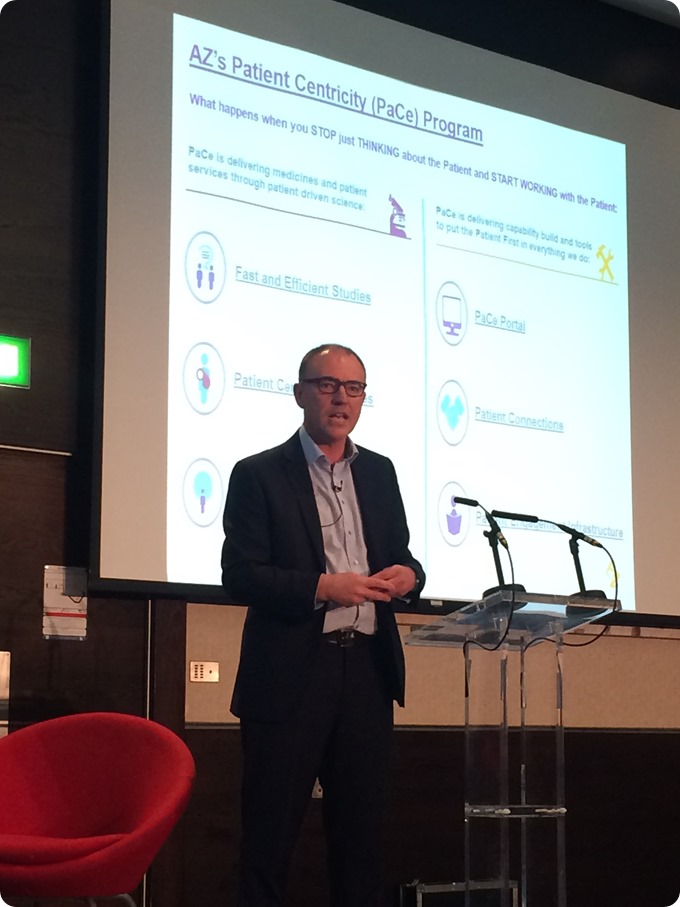An interview with Guy Yeoman, AstraZeneca, conducted by April Cashin-Garbutt, MA (Cantab)
How was ‘patient centricity’ recently defined in BMJ Innovations and how did you arrive at this definition?
Putting the patient first in an open and sustained engagement of the patient to respectfully and compassionately achieve the best experience and outcome for that person and their family.”
We started the work a couple of years ago. We acknowledged the importance of patient engagement for research and development (R&D) and created a patient centricity team here at AstraZeneca.
I knew it was key that we went right back to basics to understand what patient centricity means for patients, so we did primary literature research, background reading on the subject.
It was clear there wasn't a single aligned definition of what patient centricity actually is and that it means different things to different people, within and across organizations.
So we gathered a group of patients and carers, firstly in Europe and then in North America to begin to understand their perspectives. I have to say, it was a quite painful process because they told us we were wrong in terms of our initial thoughts on the subject.
From both North America and Europe, the message was very clear, which was "stop just focusing on the what you deliver and start focusing more on the how you deliver it because if you get the 'how' part right, then the 'what' becomes then so much more meaningful for us.”
So together with the patients and carers we had assembled, we worked through what a collaborative definition could look like and we subsequently validated it, certainly the principles, with over 1000 patients, through online communities.
We validated it through PatientsLikeMe, which is primarily a North American-based group of patients, and also through Carenity, a primarily European-based group of patients. There was a good deal of consistency and alignment, so we were very confident that the principles we worked up, all extensively with a group of patients, was probably applicable across Western Europe and America.
That's how we drafted this inclusive, collaborative definition and published it with patients. The patients have been co-authors of this particular publication. It's been a truly collaborative process.

Credit: Spotmatik Ltd/Shutterstock.com
Why has it taken so long to arrive at this collaborative definition of patient centricity?
I think the reason it has taken so long probably reflects the fundamental issue at hand. It's the industry's paternalistic approach to R&D, where we're not engaged with the end-user, the patient and primarily work with Healthcare Professionals to understand the patient perspective. I think that's part of the challenge that we're trying to address through a patient-centered transformation.
Also, it is probably that, historically, our approach as an industry has indeed been to focus on the 'what,' which is the product and not necessarily the 'how'. That's probably why it's taken a little bit of time to come up with a collaborative definition.
Do you think this outline will become the official definition for patient centricity?
This is not an official definition. It’s very much our collaborative perspective. I would love it to be debated, discussed, adapted and amended in due course. It remains in every ones interests to ensure a common understanding and alignment, so we can consistently work with patients for patient benefit...

Can you please outline the research behind the BMJ definition?
We did some background research in terms of literature searches and found that patient centricity was a concept that had been talked about for a long time within healthcare and there were various principles. I wouldn't say there was an overarching definition, but a lot of people had done quite significant pieces of work.
However, this was not necessarily the case in the R&D part of healthcare, which is why we decided to bring qualitative groups of patients together from Europe and North America. We spoke to about 20-odd patients and carers and it was clear that, from a patient perspective, these were experts from a whole range of diseases - some within our relevant sample area, but by no means restricted to our disease areas of interest. They came from all sorts of disease areas. It was clear that the patients and ourselves were struggling with what patient centricity actually means, fundamentally, for pharma R&D.
We brain-stormed some principles and potential definitions and then validated them with two online patient communities to make sure the principles that we had identified qualitatively were the right ones. So, in a nutshell, that's what we did from a research perspective.
Patricia Furlong, President and CEO of Parent Project Muscular Dystrophy, recently described this as a “landmark project”. Why is this such a milestone for the pharmaceutical industry?
Pat Furlong's an amazing individual and has extensive experience as a carer, as well as being very active in her disease area and in her negotiations with the FDA. She is a patient-carer expert. I would agree with her that this is a landmark project because it is the first time we have a collaborative understanding of what patient centricity could mean for R&D and for the pharmaceutical industry.
What feedback have you received from patients since the publication?
The patient feedback that I've had has been extremely positive to date. I think the challenge for us now is that we need to consistently demonstrate how we're delivering to that definition.
How do you plan to use this definition of patient centricity moving forward?
I think the principles, particularly, in the definition, really should underpin all our activities at AZ in how we engage patients. Those basic principles are so important and we need to consistently demonstrate to patients how we are delivering to them: patients want to have an open, sustained relationship with us; they want to be treated with respect and compassion and they want an outcome that's right for them, not necessarily what we want them to have. And I fundamentally believe these are the three important, basic principles that should underpin all the work that we do.
To give you an example of interest from other stakeholders, we were asked to talk to the FDA recently, who were particularly interested in the work that we were doing. This was specifically in terms of patient engagement activities in study delivery, in three phases, the 'pre-study' delivery phase, the 'within-the-study' delivery phase and the 'after-the-study' delivery phase.
We've done a lot of work, as have some other companies, on making sure that before the protocol is finalized, we get patient insight to help shape that protocol. We've performed a number of pilot programs including simulation of the protocol, where we carried out study visits at an investigator site with patients, to help shape the protocol development, and we have generated patient insight from online patient communities such as “PatientsLikeMe.”
As a result of the value for patients, investigator and sponsor, our clinical operations leadership team have decided that patient insight, by default, should be included in all of our development protocol processes, from this point forward. That's a really good example of the value to make sure that we're delivering a solution, in this case study research that's aligned to the definition.
And during the study, we're looking to keep patients engaged, inspired, motivated and informed about the piece of research that they are participating in. We're looking to do this digitally using digital programs that can help to do that, so that patients receive the information in a format that they understand and find relevant.
Then, after the study's finished, we're keen that we maintaina relationship with patients. Therefore, over the last few weeks, we've launched a website for patients where they can access a summary in a two-page, very simple, understandable, readable format the results of the study they participated in.
I think all those examples demonstrate how we're living the patient-centered definition. We want open, sustained relationships; we want to treat patients with compassion and respect and we want them to hold, shape and determine the right experience and outcome for them. What we're doing is very much aligned to the definition.
What is AstraZeneca’s vision for the future?
It is to live the principles that we've outlined in that definition and to start embedding patient engagement into the business process, so that we do this appropriately and effectively in a consistent manner.
It is very much a work in progress and there's a lot more to be done, but fundamentally, we want to deliver patient-friendly research that patients want to participate in and that they see the value of.
We want to ensure that patients will have helped to shape their medicines of tomorrow. By doing so, they'll truly value and understand the benefit of taking these medicines. We also want to deliver solutions that improve the patient pathway and enable patients to engage with their disease more appropriately and effectively, as opposed to ones that simply consider the patient as just a consumer of a medicine. That's our vision for the future.
Where can readers find more information?
The study is published in BMJ Innovations, which is open access and available to all.
We are also submitting an additional publication soon on the specific framework of how to effectively engage patients in R&D, to consistently deliver value for all stakeholders, including the patient.
About Guy Yeoman

Guy was appointed VP Patient Centricity at AstraZeneca in 2015. In this role he and his team are responsible to enable the delivery of patient driven science across the full lifecycle.
He has spent the last eight years with AstraZeneca, the initial two years as the UK Medical Director before moving to Asia to build an integrated medical affairs capability across Asia Pacific. More recently he established a new global Medical Evidence Centre focused on delivering integrated evidence, external science and publications.
Prior to joining AstraZeneca he spent five years at GlaxoSmithKline in clinical development, medical affairs and project management before moving to develop UK medical affairs and market access for a French company. Guy qualified in Medicine and worked in the NHS in the 1990’s.